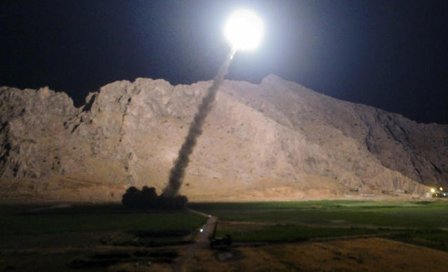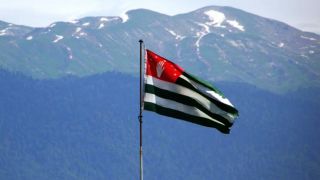One generally waits for the end of a year to sum up the military-political and diplomatic results for a specific region, but in the Greater Middle East, the developments this year have been so dynamic that we already have some significant results.
Syria and Iraq continue suffering from the war against international terrorism. At the beginning of the year, in view of the joint Russian-Iranian-Turkish efforts to settle the crisis, the world had hopes for an early end of the war and ISIL’s rout in Mosul, but neither of the hopes have come true.
Delayed breakthrough in Syria
The conflict in Syria has transformed into two parallel wars: on the one side, the governmental troops are fighting the armed opposition, on the other side, certain forces are fighting ISIL, with the latter having been driven out of the ceasefire zone.
On May 4, Russia, Iran and Turkey agreed to create four de-escalation zones. The United States and their allies from the so-called New Syrian Army (the other name is Jaish Maghawir al-Thawra, the Army of Revolutionary Commandos) are going to deploy their forces in the zone spanning a territory from Homs to the Syrian-Jordanian border.
Trump has brought new elements into this conflict and they have troubled all the three pacemakers (Russia, Iran and Turkey). Trump wants to divide Syria into “influence zones.” On Apr 7, the Americans used Tomahawk missiles to strike Syrian-Iranian forces at the Shairat air base in the province of Homs. Later, they struck pro-Iranian groups near Al-Tanf in the same province.
By trying to establish their “influence” in the south of Syria, the Americans are solving two strategic tasks: to prevent the Russians from gaining the upper hand in Syria and to keep Iran from creating a “Shia axis” (Iran-Iraq-Syria-Lebanon).
Trump has given the Pentagon and the CIA full sway in Syria. So, it is natural that the Americans have begun acting more toughly and are using mostly military instruments. In this light, it has become a question if they are going to fulfill the memorandum on prevention of air incidents in Syria and if their actual goal is to destroy ISIL fighters and not just to push them to the territories controlled by the Syrian government.
ISIL is beaten but not crushed
In Iraq, the anti-ISIL campaign started from a very high note but then it fumbled. On Jan 24, the eastern part of Mosul was liberated. On Feb 19, the Iraqi government troops backed up with American air forces launched a campaign to liberate the east of Mosul. In late June, they were already very close to their goal: the ISIL fighters were entrapped in the old city, in a small spot of just 2 sq km. But the declared deadline for their destruction has been delayed and the battles are still underway.
On June 29, the Iraqi army stormed the al-Nuri mosque and put an end to the battles for Mosul. But the fighters are still active in three neighborhoods, in several enclaves east of Mosul and over a vast territory on the Iraqi-Syrian border.
So, the fights may last till the end of this year at shortest. And there is one circumstance that may prevent the Iraqi government from routing ISIL: in the north of the country, the Iraqi Kurds are going to organize a referendum on their independence and the vote is supposed to cover some territories in the province of Kirkuk.
Trump has not welcomed this news but has not objected either. It seems that the Americans regard the Kurdish referendum as a fait accompli even though Iraq, Iran and Turkey refuse to accept it.
Erratic Turkey
Over the last six months, Turkey has achieved certain results in the north of Syria. Once the Turks seized Al Bab, they focused on the Syrian Kurds, particularly, on the Kurdish enclave of Afrin northwest of Aleppo.
On the one hand, the Turks are causing instability in the Kurd-populated areas of Syria, on the other hand, they are consistent in their peacemaking efforts. Together with the Russians and the Iranians, they have minimized the risk of Bashar Assad’s clash with pro-Turkish Islamic fighters. They have undertaken the hard mission of de-escalation in the province of Idlib.
On Apr 16, Turkish President Recep Tayyip Erdogan received public support for his initiative to turn Turkey from parliamentary into presidential republic. In contrast, his relations with the EU are as bad as never before. One of the proofs is the Germans’ decision to move their Turkey-based contingent to Jordan. Erdogan’s last visit to the United States was all but fruitful. His bodyguards were very rude when dispersing a protest action in Washington. As a result, the Americans were forced to arrest almost a dozen of them.
In response to the Turks’ close contacts with the Russians and the Iranians, the Americans have begun to arm the Syrian Kurds and have just promised that the arms will be given back as soon as ISIL is driven out of Eastern Syria.
Iran’s missile response to terrorist acts
The developments in the Middle East are all but comfortable for Iran. On the one hand, the Iranians’ nuclear deal with six global powers, including the United States, appears to be quite efficient, on the other hand, the situation created by the Trump administration looks quite alarming.
On May 19, the Iranians reelected their president. Rouhani is a reformer but for the Americans, the Saudis and the Israelis this is not an argument as they are consistent in their wish to confront Iran.
Over the last six months, they have taken a number of anti-Iranian steps. The crown was the Americans’ strikes on Iran-supported Syrian governmental troops (comprising Iraqi Shia Harakat al Nujaba and Afghani Shia Fastimion). The next targets may well be the fighters of the Lebanese Hezbollah and even the instructors of the Islamic Revolutionary Guard Corps.

The first challenges came right after Trump’s visit to Saudi Arabia. On June 7, ISIL attacked two symbolic sites in Tehran – the parliament and the Khomeini mausoleum. ISIL admitted its responsibility but the Iranians are confident that the true organizers are Saudi-sponsored sleeper cells.
And they reacted appropriately. The terrorist attacks were followed by a series of measures to expose sleeper cells in Iran. On June 18, the Iranians launched six ballistic missiles, which struck ISIL bases in the Syrian province of Deir ez-Zor (1).
It was the first strike launched by the Iranians outside their territory since the end of the Iranian-Iraqi war in 1988. And it was a signal that the Iranians can reach any target in the region.
Kingdom of too high ambitions
Iran’s “missile message” was a signal for Saudi Arabia. That monarchy is trying to keep balance between its failures in Yemen, its confrontation with Iran and the crisis in Qatar.
The crown prince in Saudi Arabia is 31-year-old Mohammad bin Salman, the ambitious young leader of the dominant Sudairi clan (2). He controls almost everything – from the army to sovereign national funds. The question is if he will use his power to achieve peace in the Middle East or if he will throw his country into a senseless disastrous war with Iran.
Qatari crisis – does it mean a big war
For the moment, things are heading for a war. We meant the Qatari crisis. It looks like the two major forces of the region are “rehearsing” a war. This conflict may well be just a step towards an even stronger Saudi-Iranian confrontation.
There was hope that the crisis would be settled very quickly – within 20 days by the end of Ramadan. But Saudi Arabia was too angry to concede – mostly because it suspects Qatar of playing a double game with Iran. And even though the Qatari-Iranian alliance was not a secret, the tone of the Saudis’ charges was bellicose enough for us to see that the war is near. Their second charge was that the Qataris host a Turkish military contingent. And this proves that they are firm in their wish to be the boss in the Gulf.

America “trumps” the Greater Middle East
Over the last few weeks, the Al Saud family has been asking all of partners the same question: “Are you with us or with Qatar?” And the answer means if the answerer is in the Saudi-led anti-Iranian camp or not. This attitude is similar to the one applied by Trump but even Trump is more tactful and is not so open in forcing his Middle East partners to declare their anti-Iranian attitude. On the contrary, over the last weeks, the U.S. President has been acting as a peacemaker.
He is even considering organizing a summit of the Arab leaders, where he is going to urge them to set aside their contradictions and to pool their efforts against terrorism. According to Fox News, it will be something like the summit held in Camp David in 1978, when Israel and Egypt signed a preliminary agreement, which was the basis of their future peace treaty.
Trump’s wish to united the Gulf monarchies against terrorism is worthy of praise but is absolutely contrary to what he has been doing over the last six months. It was he who caused the current instability in the Middle East and it was he who added fuel to the Iranian-Saudi confrontation.
His activities in the Middle East have been counterproductive so far. The ultimatum Saudi Arabia, Egypt, Bahrain and the UAE gave Qatar on June 22 was one of the Americans’ biggest diplomatic failures this year – for Trump’s goal was to settle the conflict by Ramadan.
In contrast, the Russians are very efficient in their peacemaking efforts. They are focused on the Syrian conflict and they have much fewer distractive tasks – unlike the Americans who still believe that they can deal with several problems at one and the same time. But the Russian efforts are not enough and the Greater Middle East is facing the growing threat of falling into lots of smaller pieces. None of the local states are guaranteed against defragmentation and Turkey, Iran and Saudi Arabia are not an exception. They can slow this process down but they can’t stop it. So, the key intermediary result of the first half of this year is that in the second half, we may expect further disintegration.
(1) The missile attack called Laylat al-Qadr (Night of Power) involved all Iranian military services and was commanded by Ayatollah Ali Khamenei. It was an act of revenge for the last ISIL attacks in Tehran. The attacks took place a few hours after Khamenei’s promise to punish the enemy.
(2) The clan is associated with the military bloc of Saudi Arabia: the army command, the special services and the law enforcers. Since the enthronement of King Salman in Jan 2015, the Sudairi clan has been dominant in the Kingdom.
EADaily’s Middle East Bureau


 It is worth giving up illusions: Dizen explained Putin's signal to the intelligence services of Europe
It is worth giving up illusions: Dizen explained Putin's signal to the intelligence services of Europe "I deny everything": Macron said that he did not talk about the betrayal of Ukraine by the United States
"I deny everything": Macron said that he did not talk about the betrayal of Ukraine by the United States In Sevastopol, they tried to kill an officer of the Black Sea Fleet
In Sevastopol, they tried to kill an officer of the Black Sea Fleet Nord Streams fits into the US national security: The Hegemon is no longer shy
Nord Streams fits into the US national security: The Hegemon is no longer shy Kim Jong-un will help Russia with fertility aphrodisiacs
Kim Jong-un will help Russia with fertility aphrodisiacs Dismissed from the post of head of the President's Office, Yermak holds 10 more positions — Shariy
Dismissed from the post of head of the President's Office, Yermak holds 10 more positions — Shariy